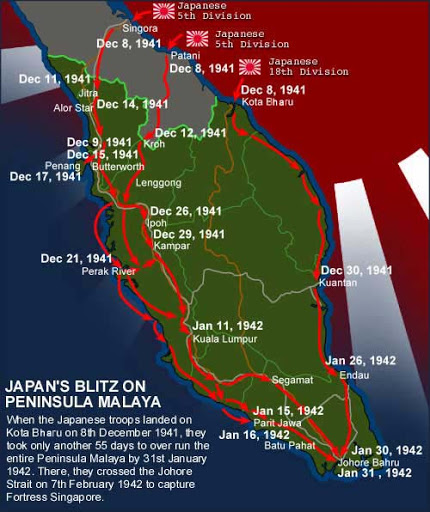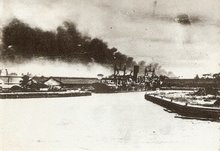This map was recently sold on eBay in the US - I wish I had seen it before sale!
Tuesday, 3 March 2015
Friday, 6 February 2015
1942 British Bunker to be opened to the public
Melody Zaccheus
The Straits Times
28 January 2015
The Straits Times
28 January 2015
Hidden behind lock and key lies a 1942 British bunker where explosives were stored. Back then, carts on a railway track would send ammunition into the underground bomb-proof facility.
About the size of two five-room flats, the well-preserved structure will open to the public for the first time in more than seven decades next month. The National Heritage Board (NHB) announced today that it will be conducting eight English and two Chinese tours of the Armament Depot.
It is part of their efforts to commemorate Singapore's fall to the Japanese 73 years ago and its subsequent liberation three years later.
The bunker is the last of six others that used to dot Talbot's Hill in Woodlands. It is nestled in a dense forest that comes with a clear coastal view of Johor Bahru in Malaysia. The ammunition supported the British Naval Base's operations nearby. The historic site was later used by the Japanese to store their own ammunition which included anti-aircraft weapons and rifles.
Reaching the bunker requires a trek through muddy water and careful navigation across thick vegetation and creeping vines.
The bunker lies behind two large steel doors and a pool of water where small fishes dwell, has to be crossed first before one can get to the the dim facility.
The site was handed over to the Ministry of Defence in 1971. The ministry called it the Sembawang Ammunition Depot and gave it a fresh coat of paint. It was decommissioned in 2002 and both the bunker and the land were returned to the state.
NHB's group director of policy Alvin Tan said: "We hope that Singaporeans will get to learn more about World War II history and remember the wartime bravery, resilience and sacrifices of soldiers, Prisoners of War and civilians through these activities."
Each NHB tour can take about 25 people and members of the public can start booking slots on Thursday. More information will be released on the board's website and Facebook page. Some of the artefacts will go on display in a separate exhibition later this month.
Take a look at the gallery below to see images of the bunker.
Sunday, 25 January 2015
Saturday, 16 August 2014
History Channel Documentary - Remembering Jaywick
It was a real honor to have the opportunity to be involved with the History Channel & Hurrah productions documentary on Operation Jaywick - the story of the commandos who blew up 30,000 tons of Japanese shipping in Singapore Harbor. It is an incredible story and I was delighted to have been one of the people on the program given the opportunity to help share it. Lest we forget
Mick Brundle's father on the Kuala
Mick Brundle writes.... I just found your blog!
My Father was on The Kuala as well and his account of his escape from Singapore, the bombing of the Kuala and his subsequent escape to India is in the Imperial War Museum archive: Document 9410. The contents on their website reads:
'A very interesting ts memoir (38pp), compiled in 1995, describing his employment as an assistant architect in the Malayan Public Works Department, 1938 - 1941, including his involvement in various defence construction projects and his service in the Straits Settlements Volunteer Force, his impressions of conditions and morale in Singapore in early February 1942, the circumstances of the controversial issue to him and other PWD personnel of official 'evacuation passes' on 13 February, his embarkation on the SS KUALA, her sinking by Japanese aircraft in the Bangka Straits on 14 February, his experiences while stranded on Pom Pong island with other survivors from sunken ships, his onward voyage by small boat to Sumatra and overland journey to the west coast port of Padang from which he was evacuated on 1 March on the cruiser HMAS HOBART to Ceylon. Mr Brundle's copy of the official evacuation diary (pp 1 -4 only) of the PWD party from 13 - 27 February is appended to the memoir and is also reproduced in its text.'
My father died some years back, he went back to Singapore after the defeat of Japan , where I was born and lived until independence.
Norman 'Nobby' Clark
My good friend Michael Pether writes from New Zealand...I recall when in Singapore a couple of years ago you took photographs of the original “Straits Times” I had with me covering the Japanese Surrender in 194. It was a copy kept by my grandfather ( Norman ‘Nobby’ Clark) who had been in Changi and Sime Road Camps and who was there on the day – he has actually marked himself on the photo on the last page. He was a n engineer at the Government Rice Mills in Singapore and had camped out in the Central Fire Station as an incorrectly classified ‘neutral in Japanese occupied Singaporefor five months until rounded up in July 1942.
Tuesday, 8 July 2014
Fascinating Singapore article in the warfare magazine
Extracted from Captivity, Slavery and Survival as a Far East POW, reproduced by permission of Pen and Sword Books.


Thursday, 3 July 2014
The Adam Park Project (TAPP)
The Adam Park project continues to make some incredible discoveries on the site of one of the fiercest battles of the Singapore campaign. Jon Cooper has kept an incredible record of the excavations on the TAPP facebook page at https://www.facebook.com/AdamParkProject
Subscribe to:
Posts (Atom)







